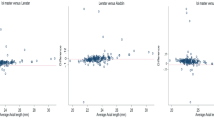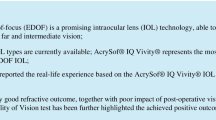Abstract
To determine the accuracy of intraocular lens (IOL) calculations in eyes undergoing phacoemulsification cataract surgery with IOL implantation using immersion A-scan ultrasound (US) and Lenstar LS 900® biometry. In this prospective study, 200 eyes of 200 patients were randomized to undergo either Lenstar LS 900® or immersion A-scan US biometry to determine the IOL dioptric power prior to phacoemulsification cataract surgery. Post-operative refractive outcomes of these two groups of patients were compared. The result showed no significant difference between the target spherical equivalent (SE) and the post-operative SE value by the Lenstar LS 900® (p value = 0.632) or immersion A-scan US biometry (p value = 0.438) devices. The magnitude of difference between the two biometric devices were not significantly different (p value = 0.868). There was no significant difference in the predicted post-operative refractive outcome between immersion A-scan US biometry and Lenstar LS 900®. Based on the results, the immersion A-scan US technique is as accurate as Lenstar LS 900® in the hands of an experienced operator.




Similar content being viewed by others
References
Jasvinder S, Khang TF, Sarinder KKS, Loo VP, Subrayan V (2011) Agreement analysis of Lenstar with other techniques of biometry. Eye 25:717–724
Nemeth G, Nagy A, Berta A, Modis LJ (2012) Comparison of intraocular lens power prediction using immersion ultrasound and optical biometry with and without formula optimization. Graefes Arch Clin Exp Ophthalmol 250(9):1321–1325
Landers J, Goggin M (2009) Comparison of refractive outcomes using immersion ultrasound biometry and IOL master biometry. Clin Exp 37:566–569
Narvaez J, Cherwek DH, Stulting RD, Waldron R, Zimmerman GJ, Wessels IE, Waring GO III (2008) Comparing Immersion ultrasound with partial coherence interferometry for intraocular lens power calculation. Ophthalmic Surg Lasers Imaging 39:30–34
Lam S (2013) Comparing optical low coherence reflectometry and immersion ultrasound in refractive outcome after cataract surgery. J Cataract Refract Surg 39(2):297–298
Fendl O, Kriechbaum K, Sacu S et al (2003) Influence of operator experience on the performance of ultrasound biometry compared to optical biometry before cataract surgery. J Cataract Refract Surg 29:1950–1955
Trivedi RH, Wilson ME (2011) Prediction error after pediatric cataract surgery with intraocular lens implantation: contact versus immersion A-scan biometry. J Cataract Refract Surg 37:501–505
Chang SW, Yu CY, Chen DP (2009) Comparison of intraocular lens power calculation by the IOL master in phakic and eyes with hydrophobic acrylic lenses. Ophthalmology 116:1336–1342
Hennessy MP, Chan DG (2003) Contact versus immersion biometry of axial length before cataract surgery. J Cataract Refract Surg 29:2195–2198
Watson A, Armstrong R (1999) Contact or immersion technique for axial length measurement? Aust N Z J Ophthalmol 27:49–51
Olsen T, Nielsen PJ (1989) Immersion versus contact technique in the measurement of axial length by ultrasound. Acta Ophthalmol (Copenh) 67:101–102
Shammas HJ (1984) A comparison of immersion and contact techniques for axial length measurement. Am Intra-Ocular Implant Soc J 10:444–447
Tsang CS, Chong GS, Yiu EP, Ho CK (2003) Intraocular lens power calculation formulas in Chinese eyes with high axial myopia. J Cataract Refract Surg 29(7):1358–1364
Gale RP, Saldana M, Johnston RL, Zuberbuhler B, McKibbin M (2009) Benchmark standards for refractive outcomes after NHS cataract surgery. Eye 23:149–152
Hahn U, Krummenauer F, Kolbl B, Neuhann T, Schayan-Araghi K, Schmickler S, von Wolff K, Weindler J, Will T, Neuhann I (2011) Determination of valid benchmarks for outcome indicators in cataract surgery; a multicenter, prospective cohort trial. Ophthalmology 118:2011–2105
Butcher JM, O’Brien C (1991) The reproducibility of biometry and keratometry measurements. Eye 5:708–711
Raj PS, Ilango B, Watson A (1998) Measurement of axial length in the calculation of intraocular lens power. Eye 12:227–229
Conflict of interests
Neither author has financial or propriety interest in any of the material or methods mentioned.
Author information
Authors and Affiliations
Corresponding author
Rights and permissions
About this article
Cite this article
Naicker, P., Sundralingam, S., Peyman, M. et al. Refractive outcomes comparison between the Lenstar LS 900® optical biometry and immersion A-scan ultrasound. Int Ophthalmol 35, 459–466 (2015). https://doi.org/10.1007/s10792-014-9970-4
Received:
Accepted:
Published:
Issue Date:
DOI: https://doi.org/10.1007/s10792-014-9970-4




